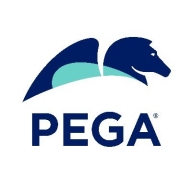

Pega Platform and AuraQuantic compete in the business process management category, each offering distinct advantages. Pega Platform appears to have an edge in robust features and long-term ROI, while AuraQuantic is notable for deployment flexibility and customer service.
Features: Pega Platform is recognized for comprehensive automation capabilities, AI-driven decision-making, and scalability, ideal for enterprise-level operations. AuraQuantic offers a highly customizable environment, strong integration options, and agility for organizations seeking adaptable solutions.
Room for Improvement: Pega Platform could enhance implementation speed and simplify initial setup complexities. AuraQuantic may benefit from expanding its advanced automation features and optimizing large-scale processes. Both platforms could improve user training resources for easier onboarding.
Ease of Deployment and Customer Service: AuraQuantic's deployment is flexible and easy, supported by excellent customer service. Pega Platform requires a structured implementation but offers consistent performance, though with less flexibility.
Pricing and ROI: Pega Platform generally demands a higher initial setup investment, offset by significant long-term ROI from efficiency gains. AuraQuantic presents more competitive initial pricing with faster returns, appealing to budget-conscious organizations.
The technical support from Pega is very low, rating a one or two out of ten.
I never needed support from the platform standpoint, but if additional features are required, we have regular meetings with the product team for feedback.
Pega's technical support team is very helpful.
Currently, big banking providers and insurance providers, even the members for healthcare payers, are using more than millions of operations on a daily or weekly basis.
With the recent development of AI agents in Pega Platform 24.2, the adoption is not heavy due to regulations around using external LLM by customers, especially regulated customers in BFSS and healthcare.
Pega introduced Constellation, which allows a user to build a more engaging visual experience.
My learning curve in robotics has been challenging.
Pega is priced higher than open-source options like Flowable but is suitable for large-scale industries like banking and insurance.
The pricing is expensive, and this is an issue.
From a licensing perspective, it is higher than the competition.
Management capabilities such as dashboards.
Pega Platform is excellent for enterprise-level solutions with integrations to entire systems, including case management, service orchestration, CRM, decision-making capabilities, digital process automation, and AI-driven functionalities.
| Product | Market Share (%) |
|---|---|
| Pega Platform | 5.0% |
| AuraQuantic | 0.6% |
| Other | 94.4% |


| Company Size | Count |
|---|---|
| Small Business | 8 |
| Company Size | Count |
|---|---|
| Small Business | 9 |
| Midsize Enterprise | 15 |
| Large Enterprise | 68 |
AuraQuantic is a digital platform designed for business users to easily and rapidly build unlimited processes and applications to automate end-to-end operations, reducing costs and optimizing productivity.
AuraQuantic is a no-code platform for building the enterprise solutions that drive Digital Transformation.
Delight users with attractive interfaces across multiple devices and deliver the best user experience. Respond immediately to their ever-changing needs with the agility provided by the platform and its no-code changes on the fly.
This is the most powerful part of any application. This is why AuraQuantic offers a long list of built-in, no-code functionalities.
To manage application and process data models, AuraQuantic provides a visual data model designer and supports importing data schemas.
Access rights management (to apps and app development), Application metadata collection, Application performance monitoring, Application works dashboard, Custom ‘guardrails’ for practitioners/developers, Role-based access control to data and services for app dev, Multiple practitioners/developers for a single app and across the platform.
Digital Decisioning features aim to inform and automate operational decisions. These decisions continue to increase in amount and complexity due to growing customer demands. Business decision automation is a must to keep up with ever-changing customer needs.
Thanks to business activity data collection, using custom applications built with AuraQuantic, the organization is empowered to carry out accurate analysis and act smart by leveraging business insights.
API REST, API SOAP, API DLL
Exposing APIs (process/application logic and decision systems)
Connector builder
REST and SOAP web services connector
External database connectors (Adapters Servers, scripts and stored procedures execution)
.Net Assembly connector Connectors with Artificial Intelligence services (AI)
Robotic Process Automation (RPA) service connectors
More built-in connectors (50+)
Microsoft Office 365, Google Suite, SAP…
Pega Platform provides flexible business process management with a focus on rapid application development and automation through a low-code approach, enhancing efficiency across sectors.
Pega Platform is renowned for its ability to streamline operations with robust automation features, including robotic process automation and decision-making capabilities. Its intuitive interface and workflow management contribute to a reputation for enhancing business processes. Although users face challenges with integration limitations and high licensing costs, they benefit from rapid deployment and efficient process adaptations. The unified architecture reduces complexity, while case management and integration services support digital transformations in sectors such as banking, insurance, and healthcare.
What are the key features of Pega Platform?In industries like insurance, banking, healthcare, and government, Pega Platform is implemented to automate diverse workflows, supporting initiatives from claims processing to customer onboarding. Enterprises use Pega for case management and digital transformations, valuing its out-of-the-box integrations and real-time reporting capabilities to boost operational automation and enhance customer experiences.
We monitor all Business Process Management (BPM) reviews to prevent fraudulent reviews and keep review quality high. We do not post reviews by company employees or direct competitors. We validate each review for authenticity via cross-reference with LinkedIn, and personal follow-up with the reviewer when necessary.